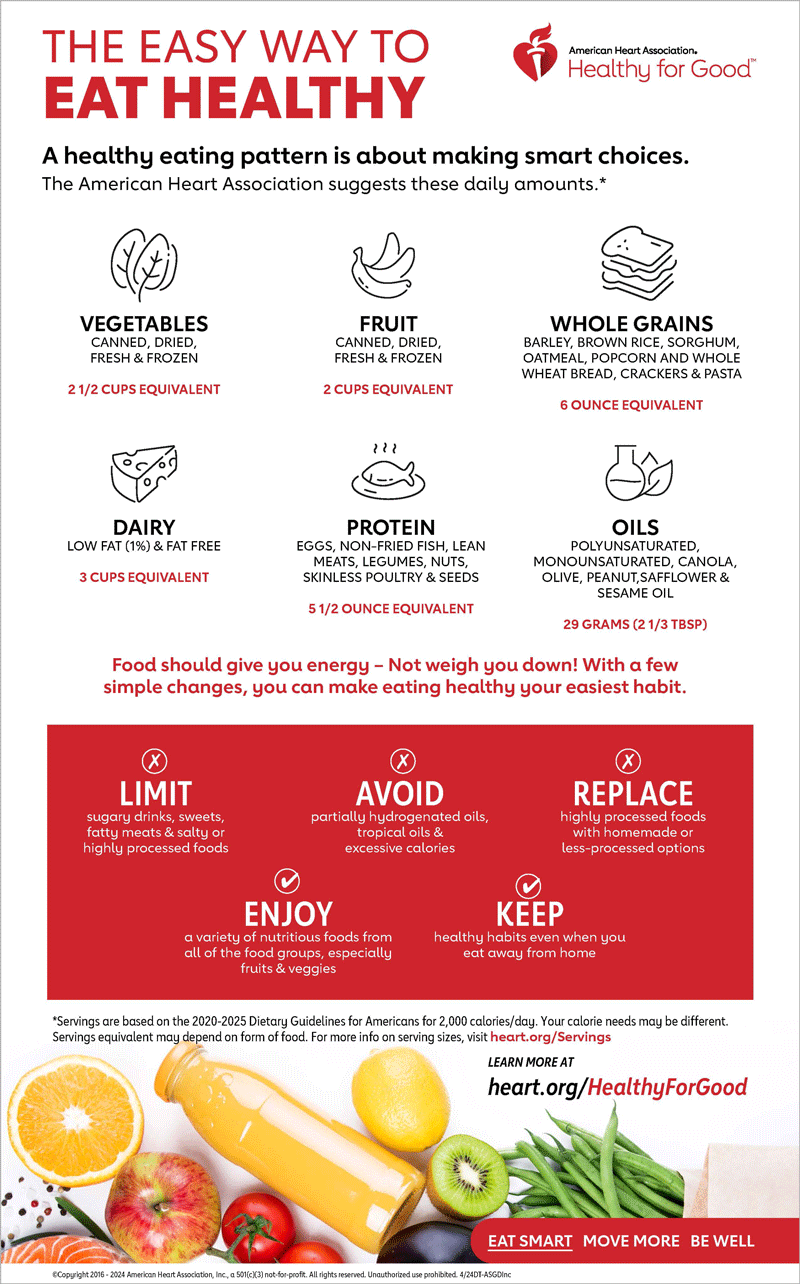 illustration from American Heart Association
illustration from American Heart Association
Mastering the Nutrition Facts: Your Simple Guide to Healthier Food Choices
Walking down the grocery aisle can feel overwhelming with so many products competing for your attention. But what if you had a secret weapon to help you choose foods that truly nourish you? That weapon is the food label, and learning to decode it is key to making informed, healthier choices for yourself and your family.
Why Bother with Food Labels?
Understanding the Nutrition Facts label and ingredients list empowers you to:
- Choose Healthier Options: Easily spot foods lower in sodium, unhealthy fats, and added sugars.
- Manage Dietary Needs: Quickly identify allergens or ingredients you need to avoid (like gluten, dairy, or nuts).
- Control Portions: Understand realistic serving sizes and calorie counts to help manage your weight.
- Compare Products Smartly: Evaluate different brands side-by-side to find the best nutritional value.
- Boost Overall Well-being: Make conscious choices that contribute to better long-term health.
Breaking Down the Label: Key Sections Explained
1. Start Here: Serving Size & Servings Per Container
This is the absolute foundation. All nutrient information listed applies to ONE serving size.
- Check the Amount: Is the listed serving size close to the amount you actually eat? Many packages contain multiple servings.
- Do the Math: If you eat double the serving size, you must double all the nutrient values (calories, fat, sugar, etc.).
2. Calories: Your Energy Snapshot
Calories measure the energy you get from a serving of the food. This is crucial for weight management.
- Calories per Serving: The main number tells you the energy in one serving.
- General Guide: Per serving, 40 calories is low, 100 is moderate, and 400+ is high.
3. Navigate Nutrients: What to Limit, What to Get Enough Of
This section details the key nutrients in one serving.
Limit These Nutrients:
- Saturated Fat: Linked to increased risk of heart disease. Aim for low amounts.
- Trans Fat: Avoid as much as possible. Look for "0g" and check the ingredients list for "partially hydrogenated oils."
- Sodium: High intake is linked to high blood pressure. Most people consume too much.
- Added Sugars: Sugars added during processing (not naturally occurring sugars like those in fruit or milk). The Dietary Guidelines recommend limiting these significantly.
Get Enough of These Nutrients:
- Dietary Fiber: Important for digestion and can help manage blood sugar. Aim high!
- Protein: Essential for building and repairing body tissues.
- Vitamins & Minerals: Labels typically highlight Vitamin D, Calcium, Iron, and Potassium – nutrients many people need more of.
4. Use the % Daily Value (%DV) as Your Guide
The %DV shows how much a nutrient in one serving contributes to a total daily diet (based on 2,000 calories). It's a quick way to see if a food is high or low in a specific nutrient.
- Quick Check: 5% DV or less of a nutrient per serving is considered low.
- Quick Check: 20% DV or more of a nutrient per serving is considered high.
- Prioritize: Aim for low %DV for saturated fat, sodium, and added sugars. Aim for high %DV for dietary fiber, vitamins, and minerals.
5. Scan the Ingredients List
Ingredients are listed by weight, from the most abundant to the least.
- Order Matters: The first few ingredients make up the bulk of the product.
- Spot Hidden Sugars: Look for words ending in "-ose" (sucrose, fructose, glucose, dextrose), corn syrup, honey, molasses, etc.
- Check for Allergens: Common allergens (milk, soy, wheat, peanuts, tree nuts, eggs, fish, shellfish) are often highlighted or listed separately.
- Keep it Simple: Generally, shorter ingredient lists with recognizable items indicate less processed foods.
6. Understand Label Claims
Terms like "Low Fat," "Good Source of Fiber," or "Reduced Sodium" have specific FDA definitions. While helpful, always check the full Nutrition Facts panel for context.
- Nutrient Claims: Describe the level of a nutrient (e.g., "Fat-Free," "High in Vitamin C").
- Health Claims: Link a food/nutrient to reduced risk of disease (requires significant scientific agreement).
- Structure/Function Claims: Describe a nutrient's role in the body (e.g., "Calcium builds strong bones").
The Updated Nutrition Facts Label: Key Improvements
You'll notice some changes on newer labels, designed for easier reading:
- Bigger, Bolder Calories: Harder to miss.
- Realistic Serving Sizes: Updated to reflect what people typically eat.
- "Added Sugars" Listed Separately: Clearly shows sugars added during processing vs. naturally occurring ones.
- Key Nutrients Updated: Vitamin D and Potassium are now required; Vitamins A & C are voluntary.
Smart Label Reading Tips
- Always Check Serving Size First.
- Use %DV to Quickly Compare Products.
- Prioritize Fiber and Key Vitamins/Minerals.
- Minimize Saturated Fat, Sodium, and Especially Added Sugars.
- Don't Forget the Ingredients List!
- Beware of Front-of-Package Marketing Hype – rely on the Nutrition Facts.
Putting it into Practice: Quick Examples
- Cereal Showdown: Cereal A has 8g Added Sugars and 1g Fiber per serving. Cereal B has 2g Added Sugars and 5g Fiber per serving. Cereal B is likely the healthier choice.
- Yogurt Comparison: Yogurt A has 18g Added Sugars and 6g Protein. Yogurt B (plain Greek) has 2g *Total* Sugars (naturally occurring) and 15g Protein. Yogurt B offers less sugar and more protein.
Your Turn to Be a Label Detective!
Understanding food labels puts the power back in your hands. It's a skill that helps you cut through the noise and choose foods that genuinely support your health goals. Start practicing on your next grocery trip – you'll be a pro in no time!
What's your biggest challenge with food labels? Share your thoughts or questions below!
Published on May 2, 2025
reference: FDA website, Academy of Nutrition and Dietetics
Gema
Wordsmith and content writer passionate about creating high-quality content that informs, entertains, and inspires. Let me bring your brand's story to life.
All stories by : Gema

0 Comments